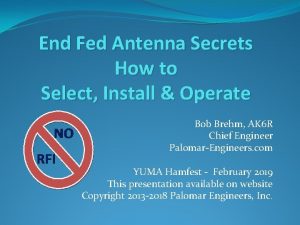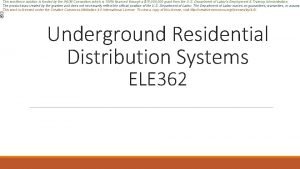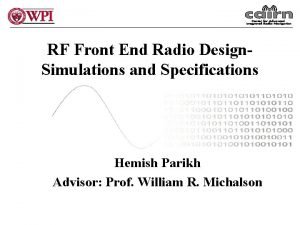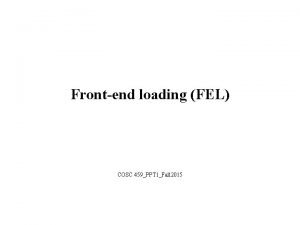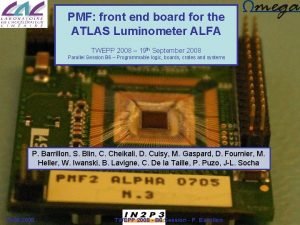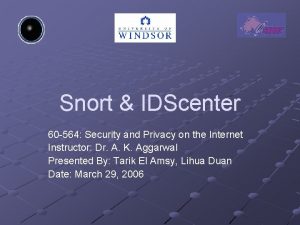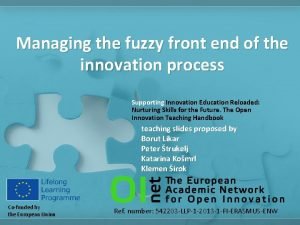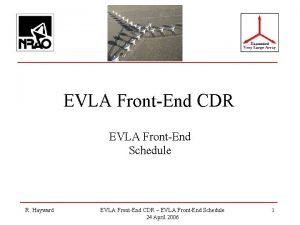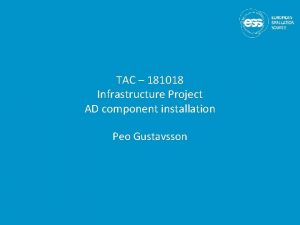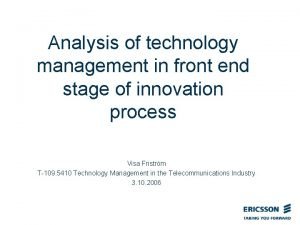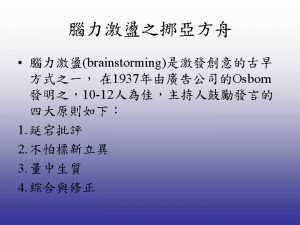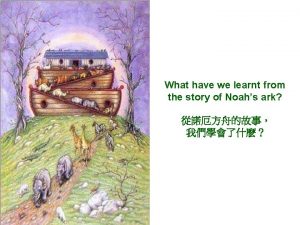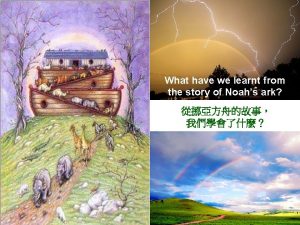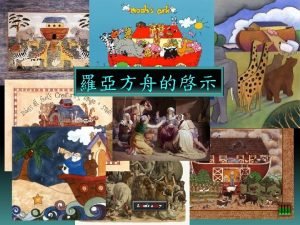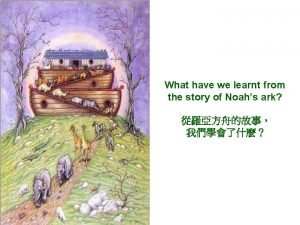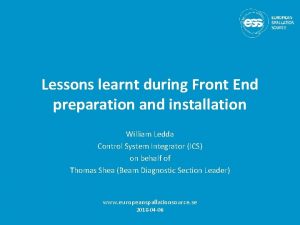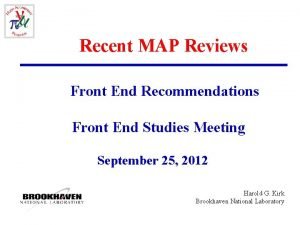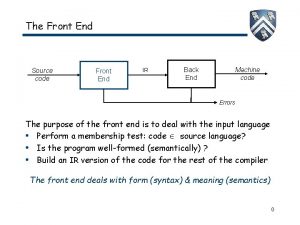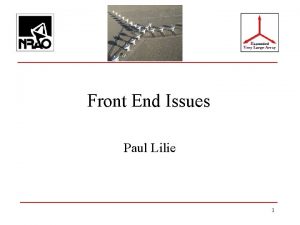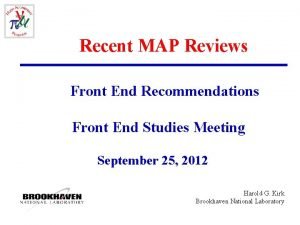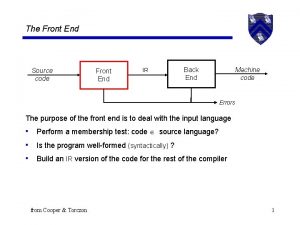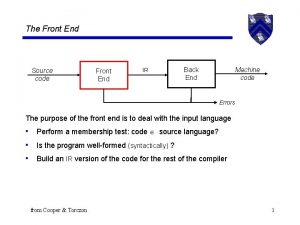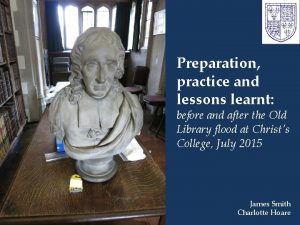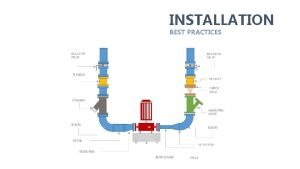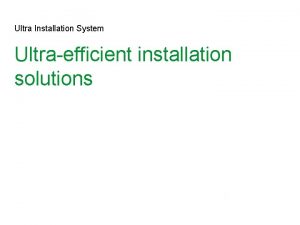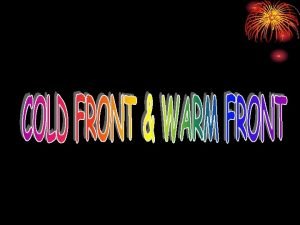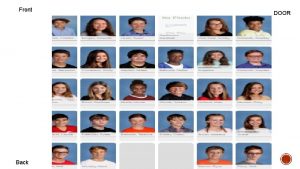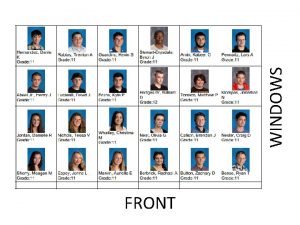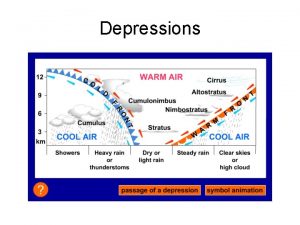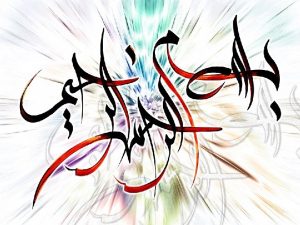Lessons learnt during Front End preparation and installation






















- Slides: 22

Lessons learnt during Front End preparation and installation William Ledda - Control System Integrator (ICS) Thomas Shea - Beam Diagnostic Section Leader www. europeanspallationsource. se 2018 -04 -12

Outline • • • Overview Organization and coordination Technical challenges Lessons learnt Conclusions 3

Overview • The "Injection system" – Ion source produce the beam – LEBT "transports" the beam till the RFQ for the first stage of acceleration • The "Control system" – Infrastructure (HW and SW) that make it possible provide required data, information and services to engineers, operators. 4

Outline • • • Overview Organization and coordination Technical challenges Lessons learnt Conclusions 5

Organization and Coordination Distributed team ESS CEA In-kind contributor for the control system INFN-LNS In-kind contributor for the ISRC and LEBT CEA ESS Accelerator Division ICS Division INFN-LNS 6

Organization and Coordination Distributed team • Relations between the teams are very good, there are bonds between the different team members. • Communications, either through phone, videoconference or in person. • Frequent travels in Catania during installation, set-up, testing and acceptance of the system 7

Organization and Coordination Distributed Development ICS intends to align distributed in-kind development of controls by distributing a development environment 8

Outline • • • Overview Organization and coordination Technical challenges Lessons learnt Conclusions 9

Technical challenges Device integration • Many different devices to be integrated – – • Different interfaces and protocols – – – • • PLCs Field devices Power Supplies … Serial vs Ethernet Modbus SCPI/GPIB Simatic step 7 Ether. CAT … The “glue” that makes all these devices communicate is the EPICS framework For the Ion source and LEBT there are – ~ 10 IOCs running – ~ 9500 EPICS PVs 10

Ion Source Controls Architecture Archiving PC Vacuum System 11 Server Scalance X 204 -2 (0) Source IPC Source PLC 4 Scalance X 212 -2 (1) Scalance X 204 -2 (2) CAT 5 Ethernet (10. 0. xxx, Channel Acces, boot, nfs, …) Serial, etc. CAT 5 Ethernet (10. 1. xxx) Fibre Electrical, etc. (physical I/O, power, etc. ) 5 Source Ether. CAT I/O 8 1 3 CU 1561 Scalance X 204 -2 (3) SCPI Repeller Electrodes PS (x 2) 2 Scalance X 212 -2 (4) 10 Scalance X 204 -2 (5) Modbus TCP 9 Modbus TCP Scalance X 212 -2 (6) Source I/O Controller ACQ Source Ether. CAT I/O Serial Server SCPI Profinet SCPI HV PS CU 1561 Magnetron ATU ASCII Mass Flow and Gauge Controller Source Coils PS (x 3) Source PLC Remote I/O HV Platform Controls Equipment (PLC, IPC, I/O, etc. ) LINAC Equipment (PS, etc. )

Serial, etc. LEBT Controls Architecture CAT 5 Ethernet Fibre ASCII 5 9 NPM MC 8 Electrical, etc. (physical I/O, power, etc. ) To Source PLC DSM IPC To Source PLC IRIS NPM To Source CB EVR DSM Spectrometer FC Chopper Camera FC Bias PS DSM BCM EMU 4 EMU Plate PS (x 2) ASCII SCPI 2 SCPI 10 EMU Ether. CAT I/O BCM I/O Controller EMU Bias PS Solenoid PS (x 2) Steerer PS (x 4) EMU MC 3 EMU I/O Controller EMU PLC s 7 plc ACQ To ISRC VME Controls ASCII IRIS MC BCT RTM Interface Unit ACQ NPM IPC 1 EMU IPC Future Controls Equipment (PLC, IPC, I/O, etc. ) LINAC Equipment (PS, etc. )

Technical challenges Control GUI • Simplified GUI for the operator to have everything under control

Technical challenges Technical compromises • The integration strategy had to be tailored and adapted to the situation – – All standards were not fully defined Not all processes were established Due to schedule pressure we were advised to keep moving forward Expertise of teams involved allowed to mitigate potential risks • Prototype timing system deployed as it was required to run the machine • Machine modes were not defined – Controls implementation made so that modes can be deployed in the future • VME system was used instead of µTCA – µTCA systems were not mature and difficult to procure • Geobrick was used instead of Ether. CAT for motion control • EPICS v 3 used for stability at the time • MPS and PSS was not implemented – However, the local protection system includes some MPS and PSS functions

Technical challenges Achievements • ISRC and LEBT is a reality!!!! – ISRC Control system accepted in July 2017 -07 – LEBT Control system accepted in 2017 -09 • Relevant documentation is available even though it still needs to be collected into one place • • • Wiring list I/O Signals Datasheets user manuals … • All EPICS modules are under configuration control • • • Version Tested Documented • All equipment is integrated in the control system

Outline • • • Overview Organization and coordination Technical challenges Lessons learnt Conclusions 16

Lessons General • Structure, methodologies, processes and standards were not fully defined since the beginning – This led to several technical compromises in the implementation • ISRC and LEBT was seen as "test stand" more than a final system – Some systems need to be updated • From VME to µTCA • Timing system • Motion control (Geobrick -> Ether. CAT) • Compression in time schedule led to take fast decisions on the fly – This require a structure inspired to the "agile" thinking • • Lesson learned: Processes and standards need to be prepared early Lesson learned: Schedule pressure creates “prototype systems” that are expensive to maintain

Lessons Organization and coordination • All the teams involved communicated regularly in a good ‘atmosphere’ – A team spread over different countries is challenging and can be very time consuming – Different teams have different views and expectations. • We have always to keep in mind how efficient the communication is – – – • Are the meetings efficient and solve problems? Do we need to have in regular meetings are they useful to improve the system understanding and speed up the process? Do we prioritize issues properly? Sometimes lack of communication and alignment between all parties – "Who is doing what? ", misunderstanding, delays • Even the strongest team players have a tendency to try to solve problems on their own • Documentation is “distributed" and sometimes not fully updated • • Lesson learned: Structured communication is essential for collaborating in a distributed team Lesson learned: Roles and responsibilities need to be clearly defined 18

Lessons Installation • This was the first time a real system installation happened at ESS – There are many experiences made that can be used in future installations • Installation work involves a huge number of decisions that should not be underestimated in terms of time • Good communication between all involved parties is essential to drive the installation in the right way • The installation should be seen as for the whole system, not “my part and then your part” • • Lesson learned: Installation requires careful planning and preparation Lesson learned: Even if we are well prepared, collaboration and communication is needed to mitigate inevitable surprises 19

Lessons Continuous Improvement Example of continuous improvement through lessons learned Experience: • Beam-induced damage of the Emittance Measurement Unit Analysis: • Delays led to aggressive commissioning schedule and ad-hoc activities. • EMU operated without complete verification. Lesson learned: conduct of operations with a proper plan and verification. Molten tungsten - Emittance Measurement Unit Lesion learned: Measure ”safe” beam prior to increasing duty factor. 20

Outline • • • Overview Organization and coordination Technical challenges Lessons learnt Conclusions 21

Conclusions • ISRC and LEBT are the first elements, result of a strong collaboration of different teams • We have had issues, of course! – We have to extract many good lessons from them in order to avoid the same mistakes. • ISRC and LEBT are the starting point from which ESS has to improve methodology, structure, process and knowledge. • The synergy between all parties is essential to avoid decision has to be reconsidered after – We have to improve communication with partners 22

Questions? Thank you!
 Front end of compiler
Front end of compiler Front end compiler
Front end compiler Palomar engineers end fed antenna
Palomar engineers end fed antenna Picture of warm front
Picture of warm front Dead front vs live front transformer
Dead front vs live front transformer Contents page magazine
Contents page magazine Front-end rounding
Front-end rounding What is front end rounding with decimals
What is front end rounding with decimals Vectron
Vectron Front end loading
Front end loading Interdash board
Interdash board Snort front end
Snort front end Front-end innovation methodology
Front-end innovation methodology Cdr
Cdr Front end inspection
Front end inspection Front end stage
Front end stage What have we learnt from the story? *
What have we learnt from the story? * What have we learnt from the story
What have we learnt from the story What have we learnt from the story? *
What have we learnt from the story? * What have we learnt from the story? *
What have we learnt from the story? * What have we learnt from the story
What have we learnt from the story Subroto's father consider subroto and his sibling with___.
Subroto's father consider subroto and his sibling with___. Lesson plan on a gift of chappals
Lesson plan on a gift of chappals


